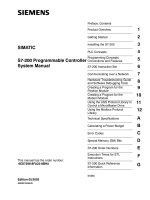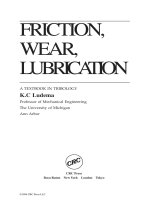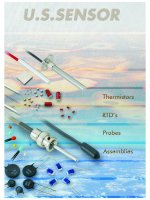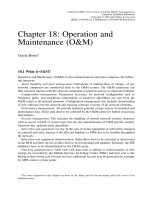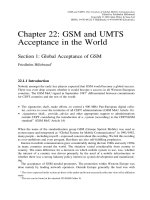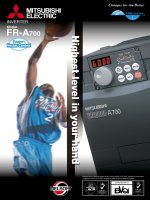Tài liệu Instrumentation and Control P1 doc
Bạn đang xem bản rút gọn của tài liệu. Xem và tải ngay bản đầy đủ của tài liệu tại đây (312.08 KB, 30 trang )
Department of Energy
Fundamentals Handbook
INSTRUMENTATION AND CONTROL
Module 1
Temperature Detectors
Temperature Detectors TABLE OF CONTENTS
TABLE OF CONTENTS
LIST OF FIGURES .................................................. ii
LIST OF TABLES ...................................................iii
REFERENCES ..................................................... iv
OBJECTIVES ...................................................... v
RESISTANCE TEMPERATURE DETECTORS (RTDs) ........................ 1
Temperature .................................................. 1
RTD Construction .............................................. 2
Summary .................................................... 4
THERMOCOUPLES ................................................. 5
Thermocouple Construction ....................................... 5
Thermocouple Operation ......................................... 6
Summary .................................................... 7
FUNCTIONAL USES OF TEMPERATURE DETECTORS ...................... 8
Functions of Temperature Detectors .................................. 8
Detector Problems .............................................. 8
Environmental Concerns .......................................... 9
Summary .................................................... 9
TEMPERATURE DETECTION CIRCUITRY ............................... 10
Bridge Circuit Construction ...................................... 10
Bridge Circuit Operation ........................................ 12
Temperature Detection Circuit ..................................... 14
Temperature Compensation ....................................... 15
Summary ................................................... 16
Rev. 0 Page i IC-01
LIST OF FIGURES Temperature Detectors
LIST OF FIGURES
Figure 1 Electrical Resistance-Temperature Curves ......................... 2
Figure 2 Internal Construction of a Typical RTD .......................... 3
Figure 3 RTD Protective Well and Terminal Head ......................... 4
Figure 4 Thermocouple Material Characteristics
When Used with Platinum ................................... 5
Figure 5 Internal Construction of a Typical Thermocouple ................... 6
Figure 6 Simple Thermocouple Circuit ................................. 6
Figure 7 Temperature-vs-Voltage Reference Table ......................... 7
Figure 8 Bridge Circuit ........................................... 11
Figure 9 Unbalanced Bridge Circuit .................................. 12
Figure 10 Balanced Bridge Circuit .................................... 13
Figure 11 Block Diagram of a Typical Temperature
Detection Circuit ......................................... 14
Figure 12 Resistance Thermometer Circuit with Precision
Resistor in Place of Resistance Bulb ........................... 15
IC-01 Page ii Rev. 0
Temperature Detectors LIST OF TABLES
LIST OF TABLES
NONE
Rev. 0 Page iii IC-01
REFERENCES Temperature Detectors
REFERENCES
Kirk, Franklin W. and Rimboi, Nicholas R., Instrumentation, Third Edition, American
Technical Publishers, ISBN 0-8269-3422-6.
Academic Program for Nuclear Power Plant Personnel, Volume IV, General Physics
Corporation, Library of Congress Card #A 397747, April 1982.
Fozard, B., Instrumentation and Control of Nuclear Reactors, ILIFFE Books Ltd., London.
Wightman, E.J., Instrumentation in Process Control, CRC Press, Cleveland, Ohio.
Rhodes, T.J. and Carroll, G.C., Industrial Instruments for Measurement and Control,
Second Edition, McGraw-Hill Book Company.
Process Measurement Fundamentals, Volume I, General Physics Corporation, ISBN 0-
87683-001-7, 1981.
IC-01 Page iv Rev. 0
Temperature Detectors OBJECTIVES
TERMINAL OBJECTIVE
1.0 Given a temperature instrument, RELATE the associated fundamental principles,
including possible failure modes, to that instrument.
ENABLING OBJECTIVES
1.1 DESCRIBE the construction of a basic RTD including:
a. Major component arrangement
b. Materials used
1.2 EXPLAIN how RTD resistance varies for the following:
a. An increase in temperature
b. A decrease in temperature
1.3 EXPLAIN how an RTD provides an output representative of the measured
temperature.
1.4 DESCRIBE the basic construction of a thermocouple including:
a. Major component arrangement
b. Materials used
1.5 EXPLAIN how a thermocouple provides an output representative of the measured
temperature.
1.6 STATE the three basic functions of temperature detectors.
1.7 DESCRIBE the two alternate methods of determining temperature when the normal
temperature sensing devices are inoperable.
1.8 STATE the two environmental concerns which can affect the accuracy and reliability of
temperature detection instrumentation.
1.9 Given a simplified schematic diagram of a basic bridge circuit, STATE the purpose of
the following components:
a. R
1
and R
2
b. R
x
c. Adjustable resistor
d. Sensitive ammeter
Rev. 0 Page v IC-01
OBJECTIVES Temperature Detectors
ENABLING OBJECTIVES (Cont.)
1.10 DESCRIBE the bridge circuit conditions that create a balanced bridge.
1.11 Given a block diagram of a basic temperature instrument detection and control system,
STATE the purpose of the following blocks:
a. RTD
b. Bridge circuit
c. DC-AC converter
d. Amplifier
e. Balancing motor/mechanical linkage
1.12 DESCRIBE the temperature instrument indication(s) for the following circuit
faults:
a. Short circuit
b. Open circuit
1.13 EXPLAIN the three methods of bridge circuit compensation for changes in
ambient temperature.
IC-01 Page vi Rev. 0
Temperature Detectors RESISTANCE TEMPERATURE DETECTORS (RTDs)
RESISTANCE TEMPERATURE DETECTORS (RTDs)
The resistance of certain metals will change as temperature changes. This
characteristic is the basis for the operation of an RTD.
EO 1.1 DESCRIBE the construction of a basic RTD including:
a. Major component arrangement
b. Materials used
EO 1.2 EXPLAIN how RTD resistance varies for the following:
a. An increase in temperature
b. A decrease in temperature
EO 1.3 EXPLAIN how an RTD provides an output
representative of the measured temperature.
Temperature
The hotness or coldness of a piece of plastic, wood, metal, or other material depends upon the
molecular activity of the material. Kinetic energy is a measure of the activity of the atoms which
make up the molecules of any material. Therefore, temperature is a measure of the kinetic
energy of the material in question.
Whether you want to know the temperature of the surrounding air, the water cooling a car’s
engine, or the components of a nuclear facility, you must have some means to measure the
kinetic energy of the material. Most temperature measuring devices use the energy of the
material or system they are monitoring to raise (or lower) the kinetic energy of the device. A
normal household thermometer is one example. The mercury, or other liquid, in the bulb of the
thermometer expands as its kinetic energy is raised. By observing how far the liquid rises in the
tube, you can tell the temperature of the measured object.
Because temperature is one of the most important parameters of a material, many instruments
have been developed to measure it. One type of detector used is the resistance temperature
detector (RTD). The RTD is used at many DOE nuclear facilities to measure temperatures of
the process or materials being monitored.
Rev. 0 Page 1 IC-01
RESISTANCE TEMPERATURE DETECTORS (RTDs) Temperature Detectors
RTD Construction
The RTD incorporates pure metals
Figure 1 Electrical Resistance-Temperature Curves
or certain alloys that increase in
resistance as temperature increases
and, conversely, decrease in
resistance as temperature
decreases. RTDs act somewhat
like an electrical transducer,
converting changes in temperature
to voltage signals by the
measurement of resistance. The
metals that are best suited for use
as RTD sensors are pure, of
uniform quality, stable within a
given range of temperature, and
able to give reproducible
resistance-temperature readings.
Only a few metals have the
properties necessary for use in
RTD elements.
RTD elements are normally constructed of platinum, copper, or nickel. These metals are best
suited for RTD applications because of their linear resistance-temperature characteristics (as
shown in Figure 1), their high coefficient of resistance, and their ability to withstand repeated
temperature cycles.
The coefficient of resistance is the change in resistance per degree change in temperature, usually
expressed as a percentage per degree of temperature. The material used must be capable of being
drawn into fine wire so that the element can be easily constructed.
IC-01 Page 2 Rev. 0
Temperature Detectors RESISTANCE TEMPERATURE DETECTORS (RTDs)
RTD elements are usually long, spring-like wires surrounded by an insulator and enclosed in a
sheath of metal. Figure 2 shows the internal construction of an RTD.
Figure 2 Internal Construction of a Typical RTD
This particular design has a platinum element that is surrounded by a porcelain insulator. The
insulator prevents a short circuit between the wire and the metal sheath.
Inconel, a nickel-iron-chromium alloy, is normally used in manufacturing the RTD sheath
because of its inherent corrosion resistance. When placed in a liquid or gas medium, the Inconel
sheath quickly reaches the temperature of the medium. The change in temperature will cause the
platinum wire to heat or cool, resulting in a proportional change in resistance.
This change in resistance is then measured by a precision resistance measuring device that is
calibrated to give the proper temperature reading. This device is normally a bridge circuit, which
will be covered in detail later in this text.
Rev. 0 Page 3 IC-01
RESISTANCE TEMPERATURE DETECTORS (RTDs) Temperature Detectors
Figure 3 shows an RTD protective well and terminal head. The well protects the RTD from
damage by the gas or liquid being measured. Protecting wells are normally made of stainless
steel, carbon steel, Inconel, or cast iron, and they are used for temperatures up to 1100°C.
Figure 3 RTD Protective Well and Terminal Head
Summary
Resistance temperature detectors (RTDs) are summarized below.
RTD Summary
The resistance of an RTD varies directly with temperature:
- As temperature increases, resistance increases.
- As temperature decreases, resistance decreases.
RTDs are constructed using a fine, pure, metallic, spring-like wire surrounded by
an insulator and enclosed in a metal sheath.
A change in temperature will cause an RTD to heat or cool, producing a
proportional change in resistance. The change in resistance is measured by a
precision device that is calibrated to give the proper temperature reading.
IC-01 Page 4 Rev. 0
